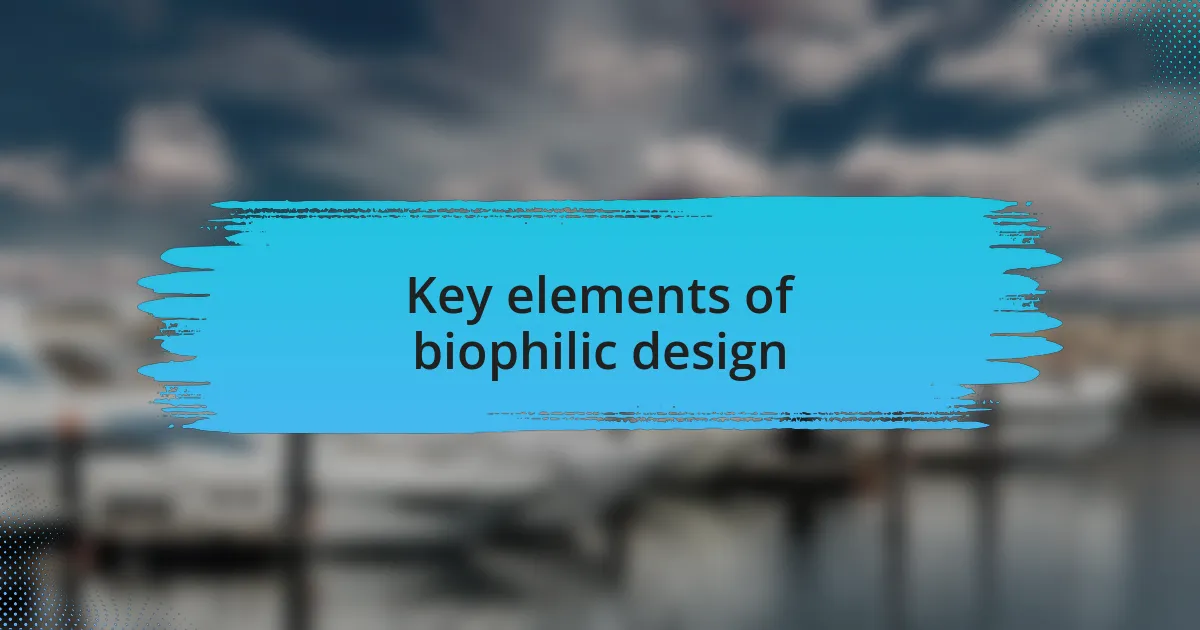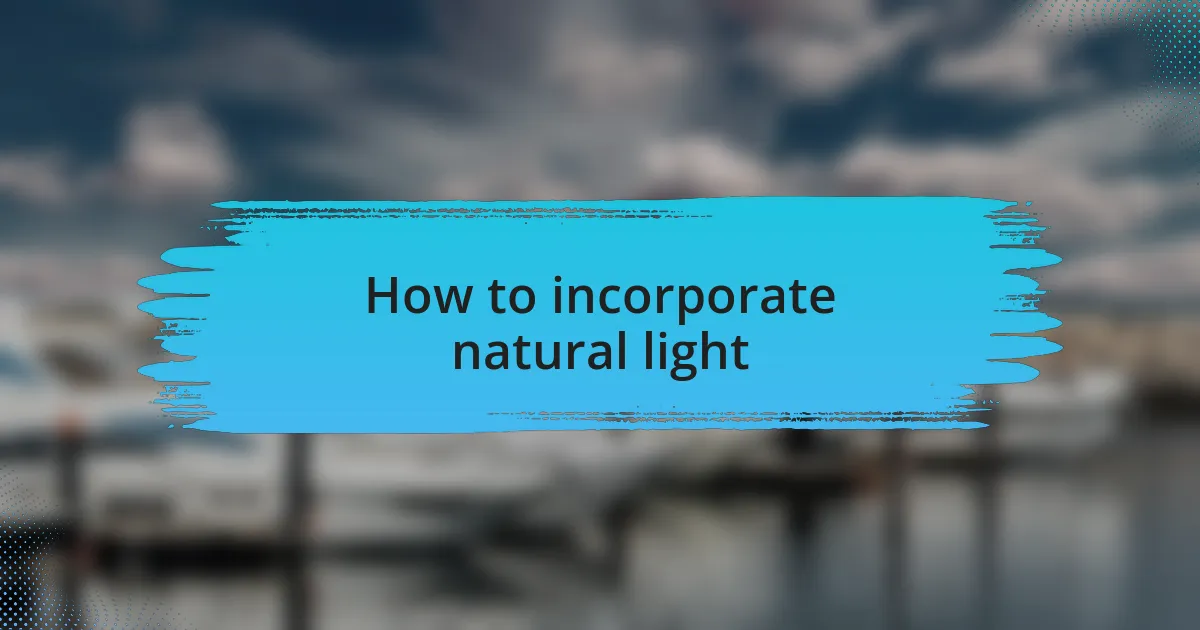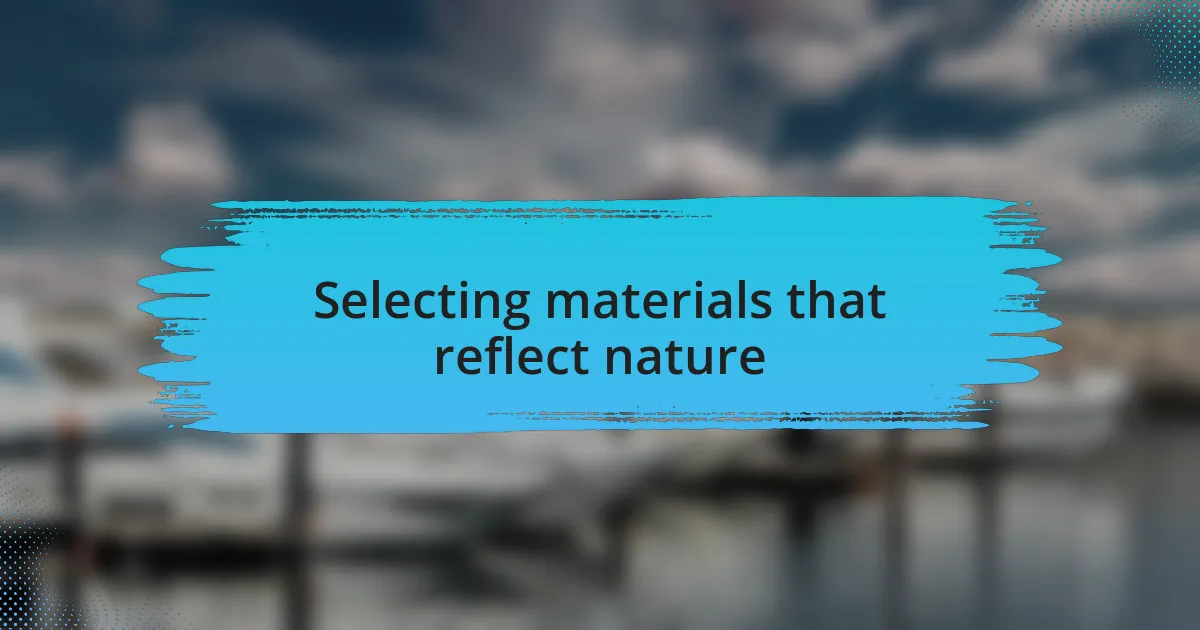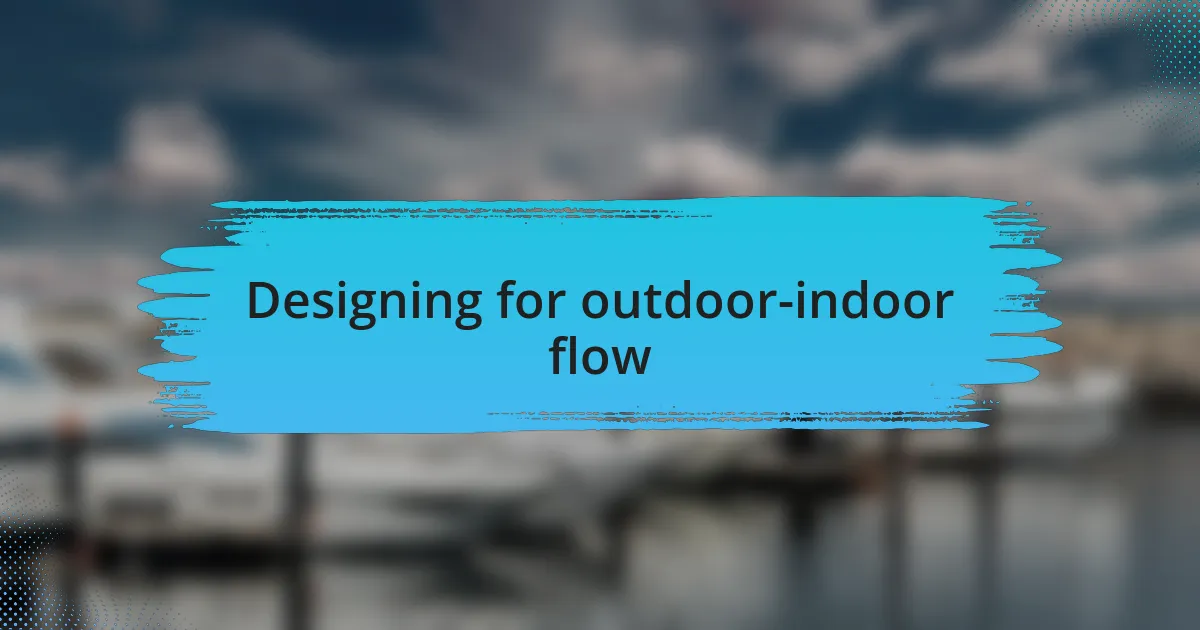Key takeaways:
- Biophilic design integrates natural elements to enhance emotional connections and well-being in built environments.
- Key elements include the use of natural materials, natural light, and nature views, which create a serene and inviting atmosphere.
- A seamless indoor-outdoor flow in design encourages users to experience spaces as interconnected, enhancing their overall sense of luxury and comfort.
- The journey of incorporating biophilic principles involves careful selection of colors and textures that evoke the essence of nature, enhancing digital experiences.

Understanding biophilic design principles
Biophilic design principles focus on our innate connection to nature, aiming to bring elements of the natural world into built environments. This idea resonates deeply with me; I remember feeling a profound sense of calm the first time I walked into a gallery that showcased natural materials and colors. It awakened a realization that the spaces we occupy can profoundly affect our mood and well-being.
I often wonder why more designers don’t embrace these principles—could it be that many have yet to experience the transformative power of natural light, plants, and organic shapes? In my own journey, incorporating these elements has not only enhanced the aesthetics of my projects but also created a sense of serenity and belonging. The way sunlight filters through large windows and dapples the floor with shifting patterns reminds me of lazy afternoons spent under leafy canopies, a feeling I strive to replicate in every design.
At its core, biophilic design emphasizes not just the visual appeal of nature, but its ability to foster emotional connections. I once collaborated on a project where we used wood accents and water features, and the response was overwhelmingly positive. Visitors felt more relaxed, even inspired, transforming their experience around luxury yachts from mere observation to something intimate and personal. Isn’t that what we aim for in design—crafting spaces where people feel both luxury and comfort?

Key elements of biophilic design
Natural materials are central to biophilic design; they evoke warmth and authenticity. I vividly remember sourcing reclaimed wood for a yacht website project, and the rich textures and organic patterns told a story of their own. Every piece seemed to connect users to the craftsmanship and natural beauty of their surroundings, transforming the browsing experience into something more than just visual pleasure.
Another key element is the incorporation of natural light. I recall a moment during a photoshoot on a luxury yacht when the sunlight poured through wide-open ports, illuminating every detail. The way that light interacted with the space not only showcased the yacht’s elegance but also created an inviting atmosphere. Have you ever noticed how different you feel when surrounded by bright, natural light? It’s not just about aesthetics; it’s about creating a sense of joy and openness that resonates with people.
Finally, incorporating views of nature can redefine the way users engage with a space. In one project, I advocated for pictures of serene water vistas alongside stunning yacht images. This simple shift sparked a deeper emotional connection, inviting visitors to dream about their next adventure. Isn’t it fascinating how a mere glimpse of a tranquil seascape can transport someone’s mind while they’re planning their luxurious getaway?

How to incorporate natural light
When incorporating natural light into a website about luxury yachts, I found that utilizing high-quality images showcasing the play of sunlight on the yacht’s interior makes a significant impact. During one project, we adjusted our photography to capture the golden hour—those moments when the light softens and glows. This isn’t just about aesthetics; the warmth and brilliance of natural light can evoke feelings of relaxation and luxury that artificial lighting simply cannot replicate.
I also made a conscious effort to include design elements on the website that reflect how natural light interacts with the spaces on board. For example, think about how open spaces with large windows can invite an abundance of light, emphasizing the serene environment of the sea. When I crafted descriptions alongside these images, I aimed to evoke the experience of walking through a yacht flooded with sunlight, encouraging visitors to visualize themselves basking in that gentle glow. Have you ever felt the sense of peace that comes from a sunlit room? It’s a subtle yet powerful experience that can enhance one’s desire to embrace the yachting lifestyle.
Lastly, I experimented with layout choices that emphasized bright, airy designs, leading the eye from one stunning image to another seamlessly. Observing how users interacted with these layouts brought me joy; the more natural light featured, the longer visitors lingered. Isn’t it remarkable how incorporating elements of nature—like light—can extend a user’s experience and connect them on a deeper level? Designing with this in mind transformed the website into a journey, making every click feel like an invitation to explore and soak up the luxurious essence of life at sea.

Selecting materials that reflect nature
Selecting materials that reflect nature was a crucial step in my design process. I opted for textures and colors that mimic elements found in marine environments, like deep blues of the ocean or sandy beige hues reminiscent of sunlit beaches. This choice created a sensory connection that draws users in, allowing them to envision the tranquil surroundings of luxury yacht living. Have you ever noticed how certain materials can evoke memories of nature? It’s fascinating how a simple texture can transport you to a serene coastline.
When curating the visual elements of the website, I incorporated natural fibers like linen and wool into the design. Choosing materials that not only look good but also feel organic added depth to the overall aesthetic. For instance, showcasing a yacht interior adorned with soft, earthy fabrics creates an inviting atmosphere that invites potential buyers to imagine themselves wrapped in comfort as they lounge on deck. It’s a small detail that makes a significant impact—don’t you think that textures have the power to influence our comfort levels?
I also focused on wood finishes that reflect the beauty of the great outdoors. Whether it’s a rich mahogany or light oak, each wood selection brings warmth and authenticity, connecting visitors to the environment. During product shoots, I remember how the reflection of wood grain under natural light added an extra layer of elegance to the yacht interiors. Isn’t it true that the right material can elevate an entire experience? By thoughtfully selecting materials that embody the essence of nature, I aimed to not just highlight yachts, but bring the serenity of nature onboard.

Designing for outdoor-indoor flow
Creating a seamless flow between outdoor and indoor spaces was a fulfilling challenge. I remember standing on the deck of a yacht, feeling the gentle breeze as it merged with the interior—a sensory experience I wanted to translate to the website. By showcasing expansive windows and open layouts, I aimed to invite that same sense of freedom into the digital space, allowing visitors to visualize the effortless transition from a sunlit deck to a cozy interior.
To enhance this flow, I integrated imagery that highlights views from the yacht’s interior looking out at the sea. These visuals not only reinforce the connection between the inside and outside but also stir a longing for adventure. Have you ever gazed out at a picturesque horizon and felt your stress dissolve? I aimed to evoke that feeling in every aspect of the design.
Finally, I paid close attention to how the content could portray the ambience of sailing in the open air. Using vibrant photography of lounges that open up to the ocean helped to create that illusion of continuity. I recall the moment I saw stunning golden hour shots that captured both the deck and the open sea—those images encapsulated the essence of luxury living. Don’t you think it’s incredible how the right visuals can transform our understanding of a space? By prioritizing outdoor-indoor flow, I hoped to inspire potential yacht owners to envision their own luxurious escapes.

My personal biophilic design journey
Embracing biophilic design principles in my website was a journey filled with discovery. I vividly recall the excitement I felt while researching elements that connect humans to nature. As I pieced together ideas, I found myself inspired by the fluidity of water and how it shapes both environments and emotions, leading me to consider how these elements could enhance the online yacht experience.
One particularly eye-opening moment occurred while curating a color palette. I decided to use oceanic blues and sandy beiges reminiscent of coastal landscapes rather than typical luxury designs. I still remember the thrill of seeing those colors come together on the screen, creating an effect that felt both calming and invigorating. It made me realize how deeply colors can influence our feelings—like the serene nostalgia one feels while gazing at a tranquil sea.
As I worked on integrating textures into the site, I envisioned how wood and soft fabrics evoke the warmth of a yacht’s interior. I began asking myself, how do we make digital experiences feel tangible? By incorporating tactile imagery, I hoped to bridge that gap, inviting visitors to not just see but also feel the essence of being aboard a luxury yacht. It was this quest for sensory engagement that fueled my passion for biophilic design, pushing me to create a site that resonates with the heart and soul of the sea.